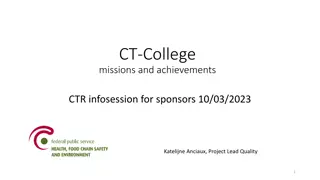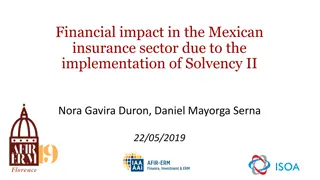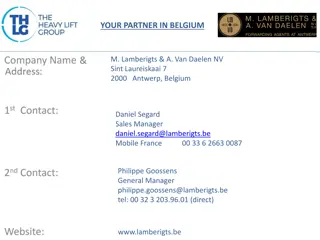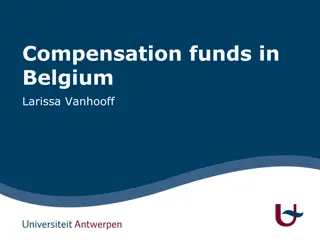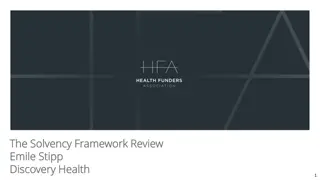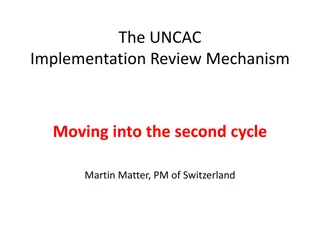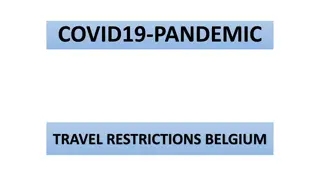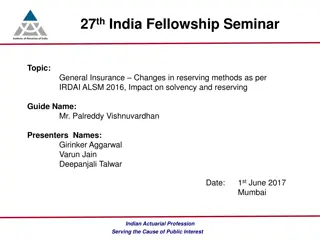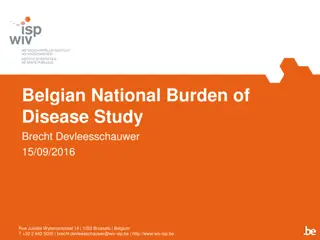Review of Solvency II Implementation and Impact in Belgium
Early adoption of Solvency II by Belgian insurance companies involved a challenging timeframe and significant costs, leading to successful implementation through intense dialogue. Strengths of Solvency II include a risk-based framework and market-consistent valuation, while weaknesses lie in coping with market volatility and disincentivizing long-term investments.
Download Presentation

Please find below an Image/Link to download the presentation.
The content on the website is provided AS IS for your information and personal use only. It may not be sold, licensed, or shared on other websites without obtaining consent from the author.If you encounter any issues during the download, it is possible that the publisher has removed the file from their server.
You are allowed to download the files provided on this website for personal or commercial use, subject to the condition that they are used lawfully. All files are the property of their respective owners.
The content on the website is provided AS IS for your information and personal use only. It may not be sold, licensed, or shared on other websites without obtaining consent from the author.
E N D
Presentation Transcript
The Review of Solvency II Paul Windels 26 April 2018 1
Implementation of Solvency II Early adaptation of the regulatory framework: Flashing light provision Governance rules Interest rate risk reporting Stress tests, etc. Belgian insurance companies early adopters with first dry runs in 2014 2
Implementation of Solvency II Challenging timeframe to implement Solvency II into practice with significant cost Successful implementation in Belgium with intense dialogue between National Bank and industry 3
From Solvency I to Solvency II Solvency requirement & own funds in millions of euros 35.000 32.656 32.008 30.000 25.000 21.784 18.233 20.000 17.554 15.000 10.215 10.000 5.000 0 Solvency I 2015 Solvency II 2015 Solvency II 2016 Ratio: 213% 186% 176% Source: Assuralia Solvency requirement Eligible own funds 4
Belgian insurers investments (including Br. 23; book values) 5
Strengths of Solvency II Risk-based framework for supervision Total balance sheet approach Capital requirement aligned with companies risk profile Market consistent valuation For almost all assets and technical provisions Largely based on the IFRS for the asset side Second and third pillar of the framework With ORSA more focus and governance into companies risk management up to level of Board of directors Public disclosure 6
Weaknesses of Solvency II Deficient measures to cope with excessive volatility in the Market Consistent Balance Sheet Mark to market of financial instruments While long term insurance portfolios are illiquid Volatility adjustment only partial solution, not designed in line with Belgian market and companies Strong disincentives for long term investments Short term risk horizon Heavy capital requirements for corporate bonds, loans with long duration and equity In combination with low interest rate environment, Solvency II affects long-term guarantees Important role for private sector in complementary pensions, but is disincentivized to provide solutions 7
The long-term issue: understanding insurers concerns Long-term and predictable liabilities allow insurers to: Hold assets long-term (or to maturity for bonds) and have control over when/if to sell Avoid losses due to forced sales Therefore insurers can reduce or eliminate exposure to temporary declines in asset prices Unfortunately Solvency II generallyassumes insurers act as traders and are fully exposed to the same volatility of market prices This is not at all the reality and it matters because it has a huge impact on how Solvency II measures market risks for insurers 8
The wrong measurement can artificially exaggerate overall capital in two ways Indirect A trading view ignores link between assets & liabilities This creates balance sheet volatility and a need for additional capital buffers Solvency ratio = Available Capital Required Capital Direct A trading view exaggerates the measured market risks (volatility) in the calculation of the capital requirements 9
The Solvency II balance sheet reflects full market volatility, but is this manageable? Fair values? Assets Liabilities Surplus capital Free assets Solvency capital requirement (SCR) Minimum capital requirement (MCR) Risk margin Best estimate Assets covering technical provisions, SCR, MCR Technical provisions Market value for hedgeable risk components 10
With no LTG measures volatility would be completely unmanageable 3 simplified insurance companies with fully cashflow matched AA assets backing 5, 10 & 15 year liabilities No long-term measures such as Volatility Adjustment or Matching Adjustment have been included 11
The Volatility Adjustment addresses the problem only partially In the case of 15 years duration the volatility adjustment (VA) helps to dampen the effect of spikes in spreads but there is still significant volatility that remains in the balance sheet. EUR Corporate AA 400% 300% 200% 15 year duration 100% 15 year duration with VA 0% 2003 2004 2005 2006 2007 2008 2009 2010 2011 2012 -100% -200% -300% 12
Enabling long-term guarantees Removing temporary volatility In theory 2 solutions are possible: Change the valuation rules for long-term assets Held to collect / held to maturity approach (amortised cost) E.g. alignment with IFRS 9 E.g. introduction of an insurance book (~ banking book) Change the valuation rules for technical provisions Using an adjustment to the risk free rate Based on the company s own asset portfolio Fully reflecting the non-fundamental spread For illiquid liabilities (life insurance or workers compensation) With limited surrender risk (e.g. group insurance or pension contracts) Without overly burdensome restrictions (e.g. ring-fencing, full cashflow replication, no future premiums, fixed cashflows) 13
Enabling long-term investments How should Credit Risk for bonds be measured? A) Trading view: Based on Credit Spreads Extreme price change AA bonds 2007 2008 = 30% B) Long-term view: Based on Credit default losses Extreme losses on AA bonds 2007 2008 = 0.4% 14
How should Credit Risk for securitisations be measured? Capital for 5-year AA STS securitisation compared to actual losses during crisis Risk for Long- term Investor Trading approach: Economically wrong and a barrier to investment even with improvements made by Commission Actual default during entire crisis period 0.14% Original Calibration (QIS5, 2009) 80% EIOPA proposal for High Quality securitisations (end- 2013) 42.5% Actual calibration chosen for SII 15% Proposed new calibration under STS approach and recognising that true risks faced by insurers (of losses from defaults) is much lower than the trading risk current assumed in the SII calibrations 5.5% Based on actual risks but set very prudently and consistent with underlying assets. Still high compared to real risks (and the SII calibrations) but would help reduce barriers to insurers investing and can be reviewed along with other calibrations. 15
The new infrastructure calibrations are a step in the right direction but enough to remove barriers? Total impact 16
Why this matters beyond the impact on insurers Allowing insurers to continue their long-term approach is vital for: Policyholders Financial stability Wider economy Consequences of getting the measures wrong: Unnecessary withdrawal of products valued by policyholders Higher prices/lower returns for policyholders Pushes insurers to invest in very low risk on behalf of their policyholder which is not the right strategy for their long-term pensions Reduces the ability in long-term and illiquid investments including infrastructure Encourage the wrong/procyclical behaviour by insurers 17
Other imperfections of Solvency II Design of the risk free rate for discounting technical provisions: need for a stable and predictable measure Concept of risk margin: is cost of capital an appropriate basis for measuring the risk margin? Important to align Solvency II and IFRS17 for efficiency and comprehension Calculation of some components of SCR too complex Excessive reporting requirements 18
Concluding remarks Level of prudence of Solvency II high To guarantee a positive impact on customers of Solvency II, rules should not become more conservative Important role for insurers in society complementing social security and supporting economic development Financial regulation should leave sufficient space for insurers Growing globalization Ensuring competitiveness of European insurance sector is key Need for alignment between Solvency II, International Capital Standard and IFRS 19
Thank you 20






